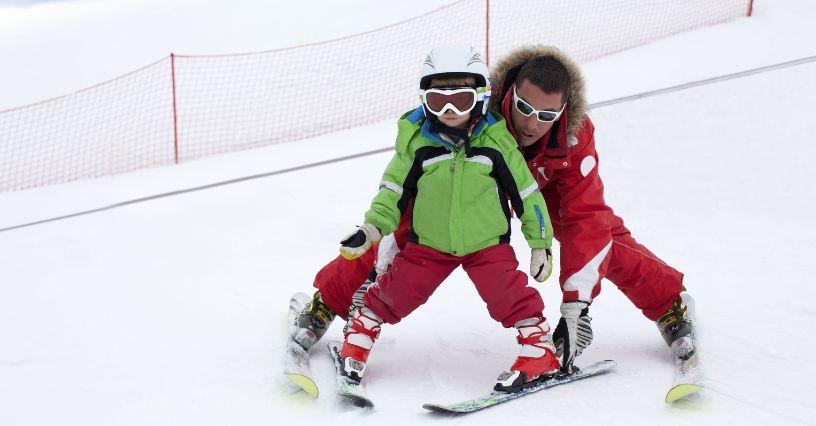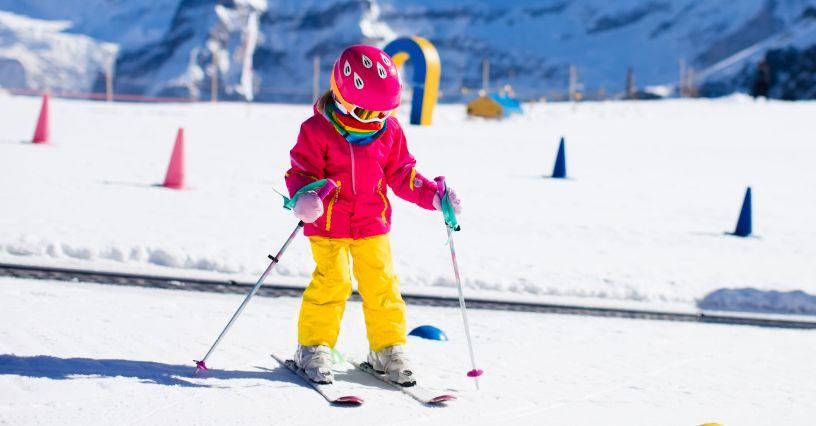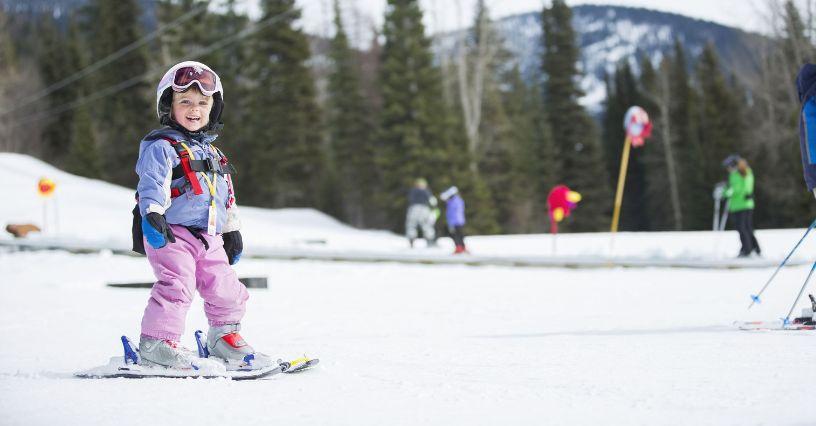Learning to ski for children is not only an introduction to the world of winter sports, but also a wonderful adventure and a skill that can be a lot of fun and help build self-confidence.
If you’re thinking of teaching your daughter or son to ski, our guide will give you practical advice on where to start, how to choose a ski instructor and what clothing and equipment you’ll need to start your skiing adventure.
At what age does a child learn to ski?
There is no strict age at which a child should start learning to ski . Usually, the first attempts can be made when the child is 3-4 years old , but the final decision should be based on his physical and mental readiness and interests. The child must be physically developed enough to cope with skiing.
Skills such as maintaining balance and controlling movements are important. Because learning to ski can be difficult and requires confidence and focus, your little one needs to be ready to take on a new challenge and express their desire to learn to ski on two skis.
Regardless of when you decide to take your first steps on skis, it’s important to give your child support, motivation and a safe learning environment.
Ski lessons for kids – with a parent or a ski instructor?
Deciding whether a child should learn to ski with a parent or an instructor depends on a number of factors, including the parent’s abilities, the availability of an instructor, and the individual needs and preferences of the boy or girl.
If a child is very young or a beginner, learning to ski with a parent can be a good idea, as the child will feel more confident and secure in the presence of mom or dad. The parent can adapt the pace of learning to the child’s abilities and needs and provide individual support. In addition, learning to ski can be an opportunity to build a bond between parent and child.
A ski instructor, on the other hand, is an experienced professional who has the knowledge and skills to teach skiing.
For beginning children, this can be more effective than learning with a parent. Especially since a qualified ski instructor can correct the student’s mistakes on the fly and thus help him acquire the correct skiing technique or execute elements such as braking, turning, etc.
For some children, taking their first steps on skis under the guidance of an instructor can be more motivating, as they may be more serious about learning in the presence of strangers.
Ultimately, the optimal solution could be a combination of parent and ski instructor. To begin with, it is advisable to turn to a professional to help your child master the basic skills and understand the principles of skiing.
After a while, you can continue to learn it on your own, developing the skills learned and enjoying the time spent together on the slopes. Regardless of who teaches your child to ski, it is important that it is a positive experience and that safety is always a priority.

A good ski instructor for children. Main features
The children’s ski instructor should have instructional training and experience working with children. It is a good idea to check that he has the relevant certificates and qualifications.
He or she must understand the specific needs and psychology of children and be able to adapt their teaching to the age and level of the students.
Children vary in ability, temperament and approach to learning, so a good instructor is able to adapt his lessons and approach to the individual needs of each student, gradually introducing new challenges and techniques.
In addition, he or she is distinguished by his or her patience and ability to explain things in a way that children understand, as well as his or her ability to encourage them to try again and correct their mistakes.
The instructor should be communicative and able to convey clear instructions and directions. Children should easily understand what they have to do.
It is important that he is able to motivate young skiers to face new challenges and promote a positive atmosphere that makes outdoor learning fun.
Ski lessons for kids should be fun and creative. The instructor can introduce different games and exercises to make learning more attractive.
In addition, positive support and praise for progress are essential to the overall experience of the little one, which can influence later interest in skiing.
An empathetic instructor is able to understand children’s feelings and fears, helping them overcome their anxiety about learning to ski.
The instructor’s first priority is the safety of the students. He or she should follow the safety rules on the slopes and provide proper care during lessons.

Individual or group? Which way of learning to ski for your child should you choose?
Choosing between individual or group ski lessons depends on a number of factors, such as your child’s abilities, preferences, instructor availability and budget. It’s also worth asking your child what suits him best and being open to his suggestions.
With individual lessons, the instructor has more time to focus on your child’s needs and abilities and adapt the study program accordingly.
Children who learn individually often master new skills more quickly because they have more time to practice and direct attention from the instructor.
Also, some children feel more comfortable learning alone or in a small group, which can help build confidence. In addition, individual lessons with a ski instructor can be more flexible in terms of availability of dates and times, as you do not have to adapt to the group’s schedule.
Instead, group ski lessons allow your child to interact socially and play with peers, which can make learning new skills more fun. Children often motivate each other in a group, which can help develop enthusiasm for exploring this winter sport and develop social skills, making friends and cooperating with others. Additionally, group lessons tend to be cheaper than individual lessons, which can be important if you’re on a tight budget.
How to prepare your child for skiing – ski equipment and the right equipment for children
Preparing the right equipment and ski clothing for a child is crucial for comfort and safety on skis. What should be included in the equipment of a beginner skier:
- skis and ski boots – must be appropriate for your child’s age and abilities.
- ski helmet – is essential to ensure maximum protection of your child’s head. Choose a helmet that fits well but is comfortable and meets the appropriate safety standards.
- ski goggles – good quality ski goggles protect your child’s eyes from wind, snow and UV rays. Make sure the glasses are the right size and guarantee good visibility.
- ski clothing – when completing your child’s ski outfit, make sure that it allows for the so-called onion dressing (layering system), which makes it possible to regulate the body temperature according to the weather conditions or the intensity of the effort. This includes: a ski jacket and trousers, functional thermal clothing for children (which provides thermal insulation and effectively wicks away moisture), warm ski socks (eg with added merino wool), good quality, waterproof gloves or mittens ( which protects the hands from cold and wetness) and a thermoactive hat (which protects the ears and head from the cold).
Where to start teaching your child to ski?
Before you hit the slopes with your child, it’s a good idea to mentally prepare them for what will happen on white snow, especially if they’ve never had skis on their feet before or if they don’t know what the sport is all about of winter.
You can start by viewing at home. If you have your own ski equipment, you can look at it together, see how it works, how it is put on, what it is used for, etc. A good option is to simulate going to the slopes, that is, putting on ski clothes or boots and having fun together.
When introducing winter sports to your child, you can use cartoons, TV programs or ski-themed games. It can be an interesting experience to go shopping together in a ski shop so that your child can participate in choosing the outfit and ski equipment.
It is a good idea to teach your child how to put on and take off his skis and ski boots and take the time to introduce him to the safety rules on the slopes, for example:
keeping a good distance from other skiers, using the lifts and of ski lifts etc. If you decide to enroll your child in a ski school, it’s a good idea to talk to him about what awaits him there and what the lesson will look like in more detail.
Once you have all your child’s ski equipment and it’s snowing outside, you can go out into the garden or on a nearby hill and try to introduce your little one to skiing through play.
This introduction can be the key to getting a child interested in skiing and eager to share their parents’ passion. Remember that learning to ski should be fun. Keep an optimistic attitude and try to create positive experiences on the slopes that will stay with your child for a long time.

Where is the best place to teach children to ski?
Ski resorts with professional ski instructors are often a good place to teach children to ski. They offer specially prepared areas for the youngest slope users – suitable slopes, infrastructure and learning conditions.
Most of the time, such slopes are gentle, well marked and equipped with facilities for children, including a children’s loop, a belt ski lift and a separate learning area.
If you don’t live in a ski area, you might consider learning to ski somewhere that’s easy to get started, like a nearby hill in a park. It is important that the location is secure. The final choice of venue will depend on a number of factors such as accessibility, budget, your child’s abilities and your personal preferences.



